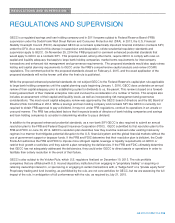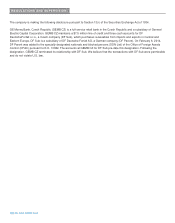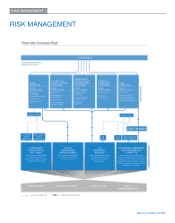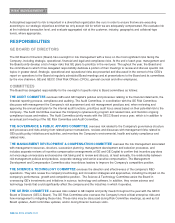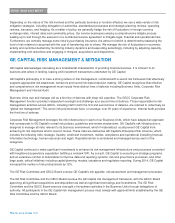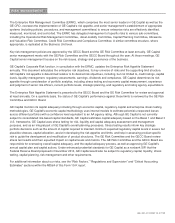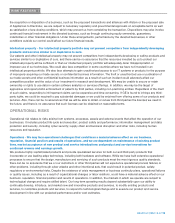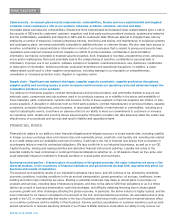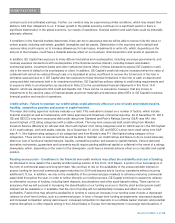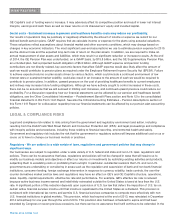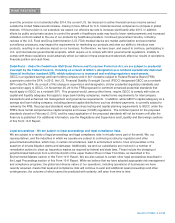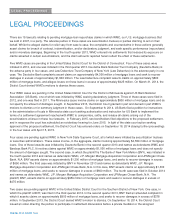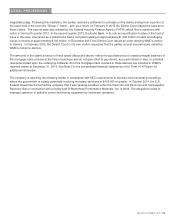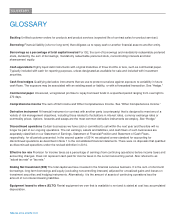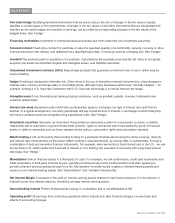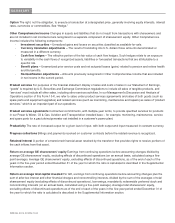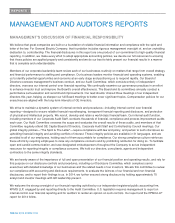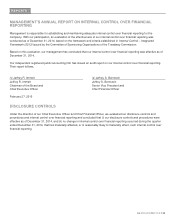GE 2014 Annual Report Download - page 135
Download and view the complete annual report
Please find page 135 of the 2014 GE annual report below. You can navigate through the pages in the report by either clicking on the pages listed below, or by using the keyword search tool below to find specific information within the annual report.
GE 2014 FORM 10-K 115
RISK FACTORS
contract costs and estimated earnings. Further, our vendors may be experiencing similar conditions, which may impact their
ability to fulfill their obligations to us. If slower growth in the global economy continues for a significant period or there is
significant deterioration in the global economy, our results of operations, financial position and cash flows could be materially
adversely affected.
If conditions in the financial markets deteriorate, there can be no assurance that we will be able to recover fully the value of
certain assets, including real estate, goodwill, intangibles and tax assets. Deterioration in the economy and in default and
recovery rates could require us to increase allowances for loan losses, impairments or write-offs, which, depending on the
amount of the increase, could have a material adverse effect on our business, financial position and results of operations.
In addition, GE Capital has exposure to many different industries and counterparties, including sovereign governments, and
routinely executes transactions with counterparties in the financial services industry, including brokers and dealers,
commercial banks, investment banks and other institutional clients. Many of these transactions expose GE Capital to credit
risk in the event of default of its counterparty or client. In addition, GE Capital’s credit risk may be increased when the value of
collateral held cannot be realized through sale or is liquidated at prices insufficient to recover the full amount of the loan or
derivative exposure due to it. GE Capital also has exposure to these financial institutions in the form of cash on deposit and
unsecured debt instruments held in its investment portfolios. GE Capital has policies relating to credit rating requirements and
to exposure limits to counterparties (as described in Note 22 to the consolidated financial statements in this Form 10-K
Report), which are designed to limit credit and liquidity risk. There can be no assurance, however, that any losses or
impairments to the carrying value of financial assets would not materially and adversely affect GE’s or GE Capital’s business,
financial position and results of operations.
Credit ratings - Failure to maintain our credit ratings could adversely affect our cost of funds and related margins,
liquidity, competitive position and access to capital markets.
The major debt rating agencies routinely evaluate our debt. This evaluation is based on a number of factors, which include
financial strength as well as transparency with rating agencies and timeliness of financial reporting. As of December 31, 2014,
GE and GECC’s long-term unsecured debt credit rating from Standard and Poor’s Ratings Service (S&P) was AA+ (the
second highest of 22 rating categories) with a stable outlook. The long-term unsecured debt credit rating from Moody’s
Investors Service (Moody’s) for GE was Aa3 (the fourth highest of 21 rating categories) and for GECC was A1 (the fifth highest
of 21 credit ratings), both with stable outlooks. As of December 31, 2014, GE and GECC’s short-term credit rating from S&P
was A-1+ (the highest rating category of six categories) and from Moody’s was P-1 (the highest rating category of four
categories). There can be no assurance that we will be able to maintain our credit ratings and failure to do so could adversely
affect our cost of funds and related margins, liquidity, competitive position and access to capital markets. Various debt and
derivative instruments, guarantees and covenants would require posting additional capital or collateral in the event of a ratings
downgrade, which, depending on the extent of the downgrade, could have a material adverse effect on our liquidity and capital
position.
Funding access/costs - Conditions in the financial and credit markets may affect the availability and cost of funding.
As disclosed in more detail in the Liquidity and Borrowings section of this Form 10-K Report, a portion of our borrowings is in
the form of commercial paper and long-term debt. We continue to rely on the availability of the unsecured debt markets to
access funding for term and commercial paper maturities for 2014 and beyond and to fund our operations without incurring
additional U.S. tax. In addition, we rely on the availability of the commercial paper markets to refinance maturing commercial
paper debt throughout the year. In order to further diversify our funding sources, GE Capital continues to expand its reliance
on alternative sources of funding, including bank deposits, securitizations and other asset-based funding. There can be no
assurance that we will succeed in increasing the diversification of our funding sources or that the short and long-term credit
markets will be available or, if available, that the cost of funding will not substantially increase and affect our overall
profitability. Factors that may affect the availability of funding or cause an increase in our funding costs include: a decreased
reliance on short-term funding, such as commercial paper, in favor of longer-term funding arrangements; decreased capacity
and increased competition among debt issuers; increased competition for deposits in our affiliate banks’ markets; and potential
market disruptions or other impacts arising in the United States or Europe from developments in sovereign debt situations. If


